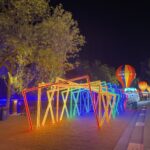The San Jie Guild Hall was built in 1750. The location was originally the prosperous urban area of ‘Rongningfang’ in the past. Therefore, the altar in front of it still has the words ‘Rongning Society’ engraved on it, and there is a couplet that says, ‘Thriving in a peaceful and happy environment, enjoying a peaceful year.’ The temple is relatively small and hidden among the majestic buildings in the urban area, witnessing the changes in the lives of local residents.
Inside the temple, Guan Di is enshrined, and the statue is exquisitely carved. When the guild hall was first established, it was only a place for merchants to hold discussions and had an important position locally. The three streets refer to Camp Street, Guianqian Street, and Caodui Street. These three streets are the ancient commercial centers of the local area, and all merchants gathered here to conduct trade. Later, due to the presence of the Guan Di Shrine and the Caishenxingjun Shrine in the hall, more and more people came to worship. Commercial activities were no longer carried out here, and it gradually lost its original function and became a temple. Every year on the eighth day of the fourth lunar month, during the Drunken Dragon Festival, if you want to witness the charm of the drunken dragon dance, many people will go to the front of the San Jie Guild Hall, either to occupy a good position for a better viewing angle; or set up tripods to prepare for taking photos. When it is Guan Di’s birthday on the thirteenth day of the fifth lunar month, a bamboo shed is built in front of the San Jie Guild Hall as a stage for performing magical operas. Outside these lively days, the San Jie Guild Hall returns to its peaceful appearance. Opening hours: Open from 9:00 to 18:00 all year round. The specific business status is subject to the opening situation on that day. Tips for visiting: It is a very small temple with only three rooms, sandwiched among various churches and Western-style buildings in Macau, and concealed by the local atmosphere of bicycles and motorcycles outside. There are many Chinese murals in the guild hall, and Guan Di is also enshrined. It is a typical Chinese architectural style.San Jie Guild Hall
The San Jie Guild Hall was built in 1750. The location was originally the prosperous urban area of &[...]









